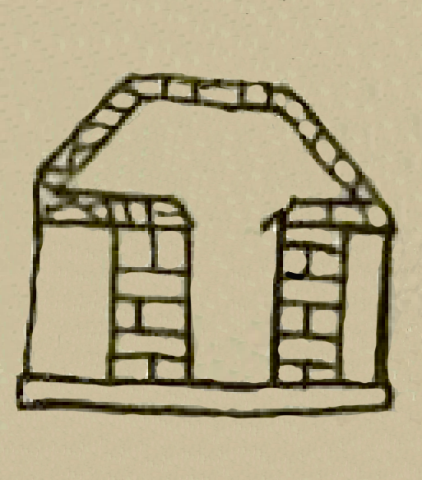michcalli (T2681:6:2r)
This simplex glyph is a fish building (calli) or compound rendered in black and white in a frontal view. It also serves as a place glyph for Michcalco (see the historical contextualizing image below). The michcalli displays what must be some European influence, in that instead of being in the more common profile view with a flat roof, this one is a frontal view with a peaked roof of a regular calli, and the entryway shows stacks of what may be rectangular stones (or perhaps adobe bricks) rather than the more typical wooden beams (see below). Gordon Whittaker (personal communication, April 2023) suggests that it is not a human habitation at all, but rather some sort of structure related to fishing or other economic activities at the site. He notes the absence of a lintel over the door opening as a factor supporting this interpretation. The michcalli also appears in the middle of a body of water; perhaps it was a structure like a fish compound, where live fish were stored before sale.
Robert Haskett
This simplex glyph appears on a pictorial manuscript submitted by indigenous petitioners from the pueblo of Cuitlahuacan, Chalco, sometime before March 24, 1579, when a canoe-born investigation was carried out of a chinampa (artificially constructed raised field in the shallow waters of a laguna) near the sujeto (dependency) of Santa María Magdalena Michcalco (also called an estançia). The community’s land tenure was being threatened by an effort of a man named Bartolomé Arias to gain a grant of this property from the viceregal authorities (an effort that ultimately failed). While Arias and several witnesses who supported him claimed that the parcel was filled with grass, used by him to pasture horses, witnesses for Santa María Magdalena and Cuitlahuacan asserted that it was customarily planted with maize, chili, and other agricultural crops. On the pictorial itself, the Michcalco calli is situated among bar-shaped figures that represent chinamitl (also called chinampas) agricultural plots and an alphabetic gloss that says “Michcalco Santa Maria Magdalena” (see the historical contextualizing image). While there is a short Nahuatl-language petition included among the folios of this case (14r), it does not mention specific crops, and it uses the loan solar (lot) rather than chinamitl or chinampa to describe it. On the other hand, a Spanish-language report of a second canoe-borne investigation (fol. 18r) states that the parcel in question is “que los indios llaman chinampas” (“what the Indians call chinampas”) and includes a brief description of how such things are built.
Robert Haskett
michcalco
Michcalco
Robert Haskett
1579
Robert Haskett
houses, casas, edificios, buildings, roofs, techos, piedras, stones, pescar, peces, pez, economía

michcal(li), fish house, https://nahuatl.wired-humanities.org/content/michcalli
cal(li), house, building, https://nahuatl.wired-humanities.org/content/calli
casa
Robert Haskett
Single-page codex, Archivo General de la Nación, México, Ramo de Tierras Vol. 2681, Exp. 6, Fol. 2r.
The Archivo General de la Nación (AGN), México, holds the original manuscript. This image is published here under a Creative Commons license, asking that you cite the AGN and this Visual Lexicon of Aztec Hieroglyphs.





